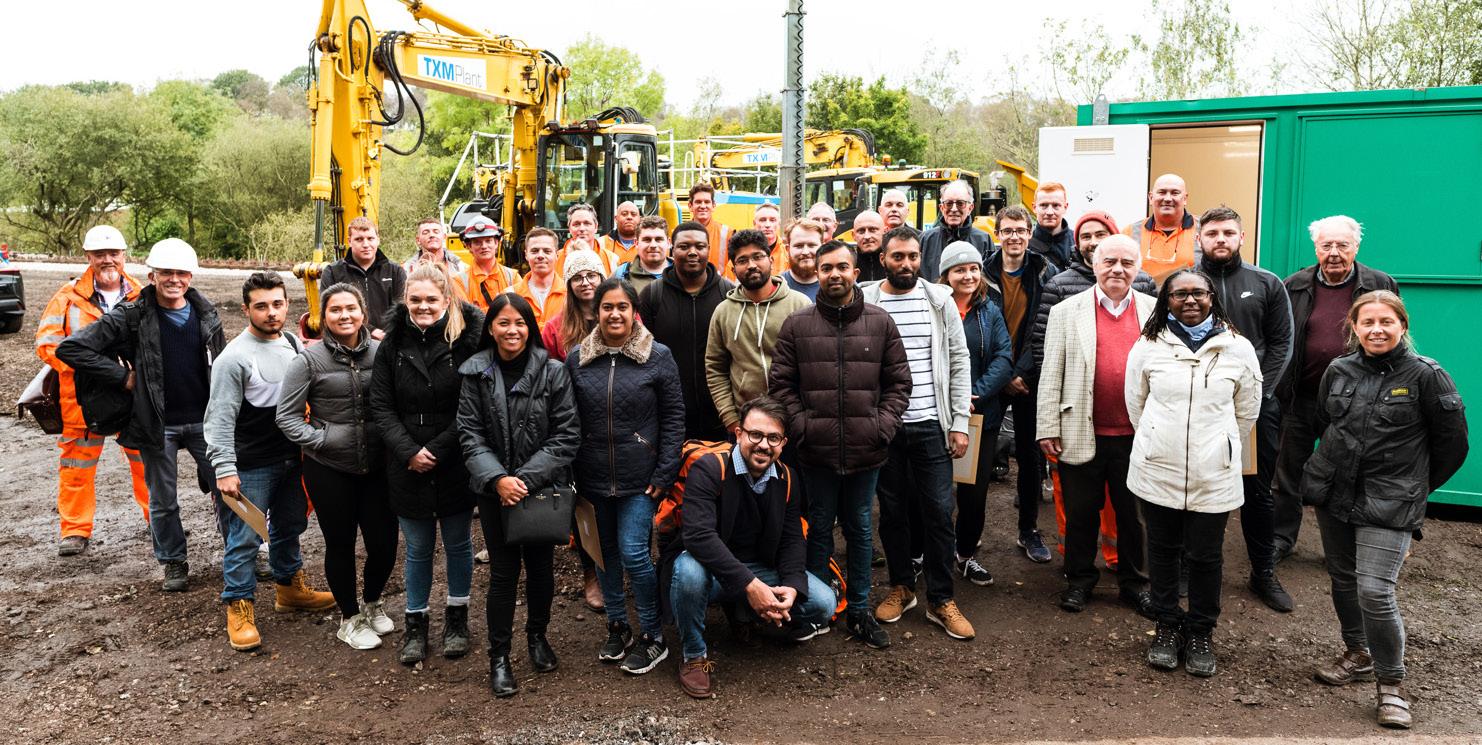
14 minute read
The High Speed 1 mid-life renewals programme
by The PWI
AUTHOR:
Robert Dean
Advertisement
Head of Route Engineering and Operations HS1
Robert is a rail industry professional with nearly 20 years’ experience in the rail and transportation sector within highspeed, UK mainline and metro railways. A Chartered Engineer and Fellow of the Institution of Civil Engineers he is currently the Head of Engineering and Operations for HS1 Ltd, the company granted the concession from government to operate, maintain and renew the UK’s only high-speed railway until 2040. He is responsible for providing client leadership to HS1’s supply chain which is supporting HS1 Ltd to protect, evolve and grow its assets.
AUTHOR:
Jonathan Scott
Director, High Speed Delivery, Network Rail (High Speed) Ltd
Jonathan has worked in the railway industry for over 28 years in operations, maintenance and projects. He has worked in the UK for British Rail, Railtrack and Network Rail as well as internationally mainly in North America. He was part of a joint UK/US team developing the design, build and maintenance of California High Speed rail. He currently leads operations, maintenance and planning for Network Rail High Speed.
AUTHOR:
Ben Straw
Head of High Speed Projects, Network Rail (High Speed) Ltd
Ben is an engineering and projects professional with over twenty years’ experience in the design, construction, operation, maintenance and renewals within the infrastructure sector for major UK and overseas projects and high speed rail. A Chartered Engineer and Member of both the Institution of Civil Engineers and Association for Project Management he is currently the Head of High Speed Projects for Network Rail (High Speed) Ltd, which is a wholly owned subsidiary of Network Rail Infrastructure Ltd, that is contracted to manage, maintain, operate and renew the UK’s only high speed line.
High Speed 1 is the only true high-speed railway in the UK and runs between London St Pancras and the Channel Tunnel. It was constructed in two phases. Section 1 between the Channel Tunnel and Fawkham Junction (south of Ebbsfleet) was opened in 2003, with Eurostar services operating on the high-speed and domestic lines through Kent into London Waterloo, continuing an operation that had started in 1994.
Section 2 was opened in 2009 and saw the routing of high-speed services through to London St Pancras at which point international operations ceased into Waterloo. At this time, domestic high-speed services started from London to Ashford, bringing the Kent town within 38 minutes of the capital with Southeastern. International passenger services (Eurostar) operate at up to 300 km/h (186mph) and Southeastern Javelin services at up to 225 km/h (140mph). There are a small number of freight services (around 2% of overall traffic) operating between the Channel Tunnel and Dagenham. Fawkham Junction is no longer used for operational traffic. Southeastern operate Javelin Class 395 trains (figure 1), Eurostar Class 374’s (figure 2) and Freight Class 92’s.
High Speed 1 was built to international (UIC) high-speed standards and is of a wide W10 gauge, with the French TVM430 ‘Transmission Voie-Machine’ in cab signalling system which extends across many high-speed lines in northern Europe. The railway is twin track and fully bi-directionally signalled with frequent cross overs. This is an in-cab signalling system with lineside markers and is comparable to ETCS level 2. At the complex station layout at St Pancras, Belgian KVB (control voi Balise) is used in conjunction with colour light signals. The system is track circuited throughout and controlled from two dedicated signalling workstations at Ashford Integrated Electronic Control Centre (IECC). Section 1 is characterised by a high-speed line across the countryside of Kent and the track is predominantly constructed on ballast. Section 2 crosses the Thames through a twin bore tunnel just north of Ebbsfleet International station. North of Dagenham, two further long twin bore tunnels traverse east London – Long Tunnel 2 between Dagenham and Stratford International which is 10,120m in length, and Long Tunnel 1 between Stratford International and the approach to St Pancras is 7,543m. The entire line has a 25kV overhead line catenary system which is integrated with the tunnel fire life safety systems and controlled from Ashford IECC.
When High Speed 1 was completed in 2009, the concession for the operation, maintenance and renewal of the line was awarded to High Speed 1 Ltd for a 30-year period. At the end of the concession in 2040, either a new concession will be let, or the ownership will transfer back to the Department for Transport. This concession also includes retail, parking and station operation at St Pancras (figure 3), Stratford, Ebbsfleet (figure 4) and the international station at Ashford.
High Speed 1 Ltd contract the operation, maintenance and renewal of the railway, as well as the station management of St Pancras, Stratford and Ebbsfleet, to Network Rail (High Speed) (NRHS), a wholly owned subsidiary of Network Rail.
The funding mechanism of the railway is different to that used on the rest of the mainline network. Train operators are charged a track access fee which incorporates the future cost of renewing railway infrastructure over the next 40 years. The renewals charge is held in an Escrow account and drawn down as renewals are required.
High Speed 1 was designed and built to provide speed and convenience. Through these it has delivered substantial economic benefits to the areas it serves. The reliability of the system plays a
crucial role. Unlike anywhere else in the UK, delays are measured in seconds rather than minutes. Typically, before the pandemic, average delays related to operations and maintenance were consistently under 7 seconds per train. In financial years 2019-20 and 2020-2021, High Speed 1 accumulated over 200 days per year without any delay at all. In 2020-21, there were 335 days with no delays due to infrastructure. Whilst it is recognised that COVID has had a significant effect on train services, the strength of performance has been driven by underlying reliability. High Speed 1’s unique selling points therefore remain its speed, convenience and reliability. These must be maintained to ensure for TOC and FOC customers that train travel is the transport mode of choice, for domestic and international destinations. The chances are if you use the system for either an international or domestic service, it will be delay and fuss free!
However, to maintain this high level of performance has meant a continuing challenge for both High Speed 1 and Network Rail. The system is classed as mid-life by the Office of Road and Rail (ORR) and it is recognised that to keep the system operating at high tolerance levels, more invasive work will need to take place. The system is financed in control periods of five-year duration which are similar to those undertaken by the wider Network Rail across the UK. This is no coincidence, as the ultimate ownership of the system is by the Department for Transport (DfT) and the regulation of the system is undertaken by the ORR, as it is in Network Rail. Control Period 1 started at service operation in 2009 and ran until 2015. During Control Period 2 (CP2) (2015-2020) the system started to show signs of mid-life ageing; some of the switch and crossings required more maintenance and replacement, and other components, particularly in signalling and telecoms, were becoming obsolete, despite being less than 15 years old. As a result, this level of heavy maintenance / light renewals required a re-think in terms of how work is undertaken, and the high level of performance maintained. The workforce had very little experience of this type of work activity and during CP2, experts from outside of High Speed 1 in the wider Network Rail and contracting organisations helped deliver this type of work. However, the aim was to manage the increasing project portfolio in-house, with the maintenance teams learning new skills to undertake some of this work themselves. The delivery of this workbank required the formation of a High Speed project renewals team with a dedicated Project Management Office (PMO) created with functional leads for Development, Delivery, Controls and Planning, Engineering Assurance, Commercial and Finance (See figure 6). The PMO is to project manage the Route and Station works agreed in the 2019 periodic review (PR19) determination from the Office of Road and Rail (ORR). Governance is undertaken in line with a gate process which sets out the control framework for the financial authority and technical assurance. The five-stage gate process draws on Association for Project Management (APM) guidance and aligns well with Network Rails’ GRIP (Governance for Railway Investment Projects) process and the recent changes of the Project SPEED and PACE (Project Acceleration in a Controlled Environment) initiatives now being introduced within the domestic UK rail industry.
Delivery of renewals is either using third-party suppliers or NRHS maintenance engineers depending on the level of complexity of a project. We procure services via a competitive tendering process using existing NR frameworks and RISQS registered contractors, typically appointed under standard forms of contract but we are starting to use target cost options to introduce supply chain incentivisation. In line with an efficient operating model, we are able to use in-house maintenance teams, via an asset management effectiveness strategy, so we have developed a selfdelivery capability and provide construction supervision for safety critical roles. All works are undertaken follow Construction Design and Management (CDM 2015) Regulations and use Active Risk Management (ARM).
Figure 7 shows the renewal costs for CP2 and 3 as we forecast costs for future control periods. As we move into preparations for CP4 and the increasing volume and value of renewals, the High Speed 1 plan is to develop an integrated renewal plan that models the work bank, access and execution of the works. Key principles of this are to ensure we meet stakeholder requirements, with minimal

Figure 2: A Eurostar Class 374 High Speed train operating on High Speed 1.


Figure 4: Ebbsfleet station on High Speed 1.
disruption and deliver value for money. Within CP3 a strategic theme has been developed to minimise disruptive engineering access through use of an integrated planning technique for resources and possessions. This will allow availability and track access charges to be optimised for existing and future service growth whilst ensuring the renewals programme of planned interventions sustains the required levels of safety and performance.
Project work has started from a very low base back in 2017 with this type of work not undertaken before on the route and continues to ramp up apace today. In 2019, the first switch and crossing renewal (figure 8) with signalling design (to a new specification) was undertaken close to the Eurotunnel boundary and there is a campaign underway for changing of switch and crossing components based on wear rates and reliability across the route. In addition, some telecoms equipment has been replaced based on being obsolete and wishing to reduce the risk of non-availability of components as well as mitigating cyber security which was not perceived as a risk when the system was designed back in the late 1990’s. This has meant some new skills being learnt by the team, supplemented by project management to help integrate the work with current inspection and maintenance. These skills will be further developed over the control period to help ensure, where possible, projects can be delivered in-house.
The Coronavirus pandemic has also provided increased focus on the need to provide efficient and effective renewals. Any delay to services as a result of engineering works may be damaging to the recovery from the pandemic. Costs must also be continually challenged to help support customers.
One of the challenges of undertaking renewal work is how to integrate with both the running of trains and the current level of inspection and maintenance work. Unlike the rest of the UK network which has organically grown the planning of work, High Speed 1 has not, so there are no engineering allowances or a long-term strategy for major engineering work agreed many years in advance with stakeholders. These are currently being examined as part of a review of engineering work and it is likely that work will be confined to more intense but less frequent blocks during the working week. Domestic and international operations often have competing aims with Eurostar, for example, seeing the opportunity for growth during Christmas day operation to allow people to move between London and Paris later in the day. At weekends, whilst Southeastern may see a lowering of traffic outside of the peak hours, Eurostar often may want to run later due, for example, to international rugby taking place in Paris. In addition, post pandemic, it appears increasingly likely that operators will prefer engineering disruption during the week rather than at weekends where a recovery in leisure traffic can be sought.
Technology plays a key part in the strategy now and going forward, as well as some challenges. High Speed 1 was built and has continued working as a ‘people-less railway’ which has always meant no red zone working. Much of the work has been undertaken using a fleet of dedicated Multi-Purpose Vehicles (MPV’s) (figure 9) which have the in-cab signalling system, TVM430 fitted. During CP3 they will be overhauled and upgraded, including the consideration of battery operation in tunnel environments with the aim of using the MPV fleet far more for efficient delivery of possessions. The entire route is bidirectionally signalled which gives flexibility in terms of running trains on one line if the workforce and equipment can be safely protected on the line which is blocked, however whilst operating in this format there is a reduction in allowable speed. Due to the wide gauge, in most locations this is far more straightforward than the rest of the UK. High Speed 1 does not have conventional speed restrictions imposed like the rest of the UK; the signalling system has the ability to provide set speed parameters in the event of any speed being required. This is undertaken both on the system and locally, in signalling switch rooms. Pre-set speeds of 80, 160
and 225 km/h are available. The system automatically controls the approach speed to reduce line speed to the target speed throughout the section. However, what this does mean is that there is a challenge to be able to hand back any work that requires a speed to this level. The reduction in speed from 300 km/h to 225 km/h on a long high-speed section is significant and therefore the delay for a sectional running time can be several minutes. If, for example, the 225 km/h parameter after work cannot be met and a 160 km/h speed restriction has to be imposed, this would have a significant effect on train services, with either cancellations or more likely bidirectional running in place.
As part of the determination for CP3 High Speed 1 was awarded £2m of research and development investment that aims to reduce operations, maintenance and renewal cost. Investment is being made in trialling train borne monitoring and inspection of assets, static forms of remote monitoring, advanced analytics and technology enabled ways of working that will improve asset knowledge, extend asset life and help deliver more efficient renewals. The use of 5G networks to facilitate some of these initiatives is also being trialled. In summary High Speed 1 is now approaching midlife. Its ongoing management requires ever increasing amounts of asset renewal activity. We face ongoing challenges related to maintaining safety, cost, sustainability and maintenance that makes our product affordable to our customers. To ensure the continued exceptional levels of high operational performance that our customers require and realise the efficiencies needed in a post-pandemic world, new technologies will be harnessed, and operations optimised.
Furthermore, not only is high performance expected on High Speed 1, but ensuring it is undertaken in a sustainable and environmentally friendly way as well as providing the flexibility to run passenger and freight services based on the unpredictable demand post pandemic will be a key challenge over future years. In doing so, High Speed 1 working in partnership with NRHS, will continue to increase the value of its asset which is then translated into value for the public purse when the concession is returned.

Figure 5: Breakdown of High Speed 1 schemes by discipline during CP3.

Figure 6: The High Speed 1 renewals team Project Management Office.


Figure 8: Switch and crossing renewal near to the Eurotunnel boundary.











